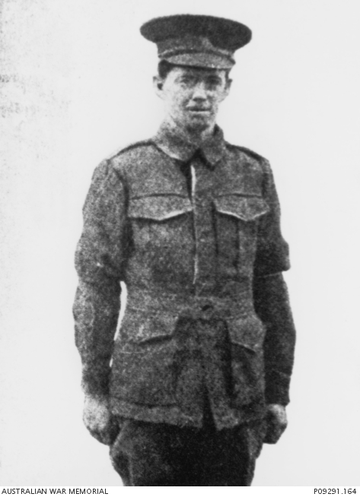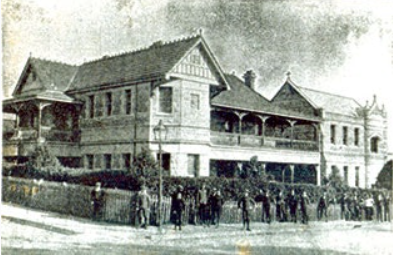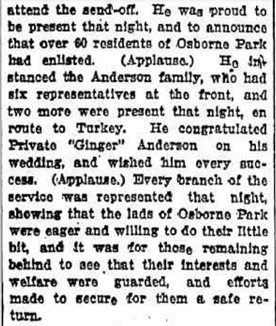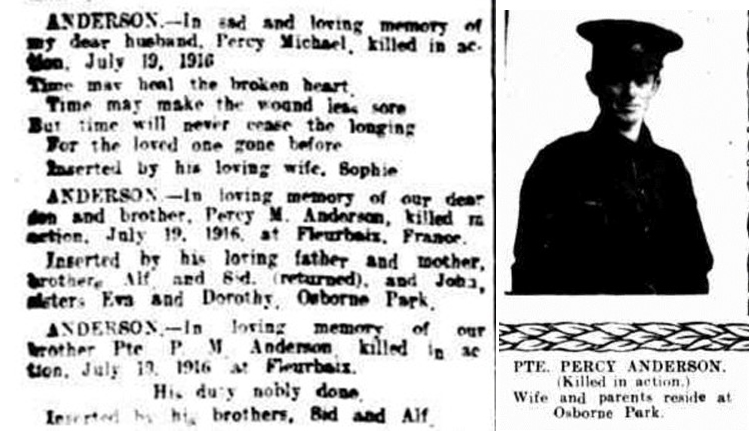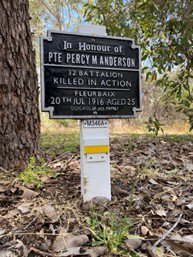Percy Michael ANDERSON
Eyes grey, Hair ginger, Complexion fair
Percy Anderson – Deeply Missed
With thanks to Deborah Giblett and Geoff Tilley – In search of Charles Albert Stokes DCM for their contribution towards this story
Percy Michael Anderson was born in Fremantle, Western Australia in 1891. He was one of eight children born to parents William and Annie Anderson (nee Griffin), who had married in Fremantle in 1888. Percy was the second oldest. He had five brothers and two sisters. Percy’s father was a printer, publisher and journalist for the Liberty Newspaper in Market Street Fremantle in 1892.
The family did make a number of moves, Percy’s younger brother, Sydney, was born in Albany in 1895, his sister, Eva, was born in Bunbury in 1900 and his brother Bernard was born back in Fremantle in 1903. Post office records also indicate that the family moved to King William Road, Osborne Park in 1908.
Percy attended school at the Christian Brothers College, Fremantle.After his schooling, Percy was employed as a hod carrier, a labourer carrying supplies to bricklayers, stonemasons, or cement finishers. Percy married Sophia Alice Boness in 1915 in Leederville, but only shortly after he had enlisted. Sophia was from Essex, England, having arrived in Fremantle in October 1910. The couple were living at Hector Street, Osborne Park.
Off to War
Enlistment for the War was a ‘family affair’. Percy signed up in July 1915 at Blackboy Hill, Perth, Western Australia. Two of Percy’s brothers as well as his father and two cousins also joined up. His brother Alfred was attached to 44th Infantry Battalion and Sydney to the Australian Army Medical Corp, 1st Field Ambulance. Both of Percy’s brothers returned to Australia in 1919.
Percy’s 45 year old father William also enlisted, Jan 1916. He had already served with the West Australian Volunteer Force. He was stationed at the No 1 Australian Auxiliary Hospital at Harefield Park in Middlesex, England for the duration of his active service. This enabled him to have met up with his son Sydney in England when Sydney was hospitalised in 1918.
Percy’s cousin Thomas Franklin Mansbridge was also with the 44th Battalion. He was killed in action on 3 June 1918 and is commemorated at Villers Bretonneux. Thomas’ brother, Colonel William Owen Mansbridge, was awarded the DSO for gallantry during operations near Gaba Tepe (Gallipoli) during the first assault on Anzac Day and subsequent assaults in May 1915. In later years he also led the search for Charles Kingsford Smith.
Source: "OLD BILL" (1929, April 11). The Daily News (Perth, WA : 1882 - 1955), p. 1 (HOME (FINAL) EDITION). Retrieved March 4, 2024, from http://nla.gov.au/nla.news-article83387610

Percy was assigned to the newly formed 32nd Battalion, which was to be made up of two companies from Western Australia and two from South Australia. He was assigned to D Company and his initial training was at Blackboy Hill, outside of Perth.
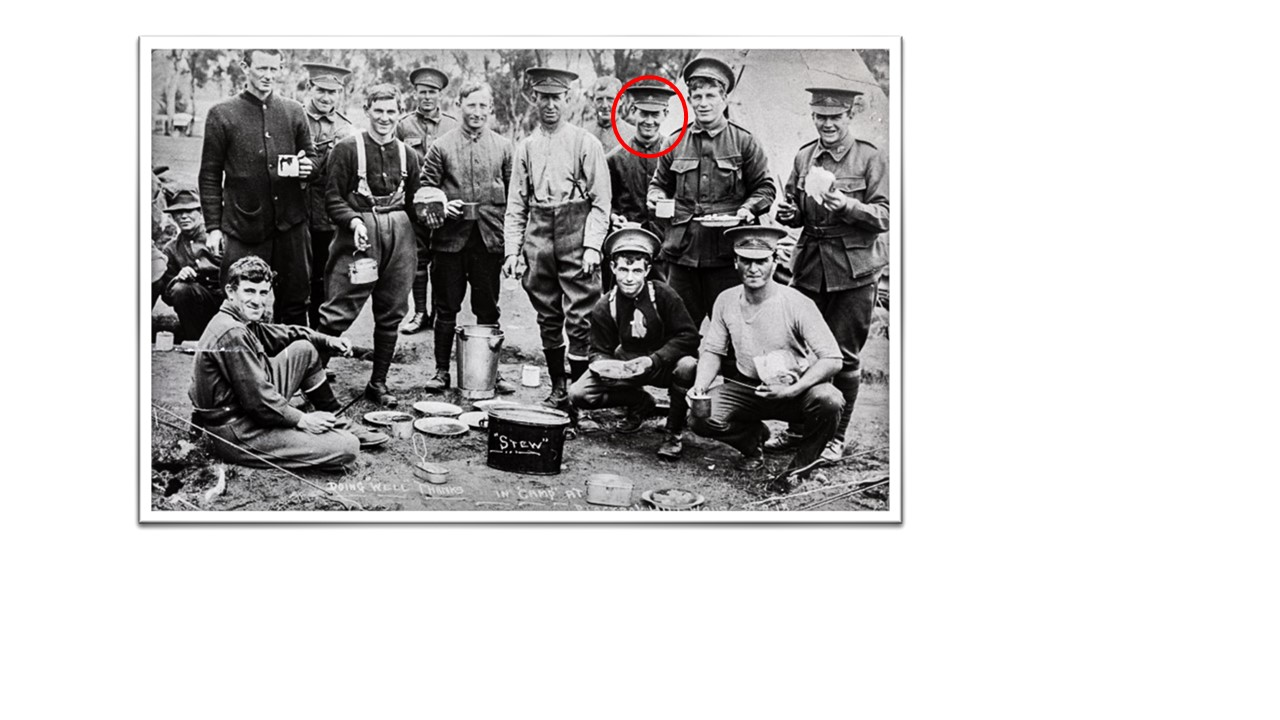
The Western Australians sailed from Fremantle to Adelaide in September to form the full battalion and continue their training. Before they left a farewell was held and Percy (nicknamed ‘Ginger’ for his hair) was congratulated on his recent wedding.
Training for the full battalion then continued in South Australia.
Percy wrote to his family in October:
“Private Percy Anderson, D Co., 32nd Battalion, writing from ‘somewhere in South Australia’ to his parents at Njookenbooroo states: We are getting on well. I have been inoculated. It does not half make you sick. We are supposed to be going to Victoria, and then ——, and we will have a long trip before we are finished. We had a good trip from W.A. We don't have to pay tram fares here like in Perth.
The food is good, sausages for breakfast, roast meat for dinner, leave from 5 to 10 every night, and Saturday from 1 until 11 on Sunday. I am keeping Tyler’s postcards till I get to the front”
The 32nd left Australia from Adelaide on 18 November 1915 aboard HMAT Geelong A2, headed for Egypt.
As reported in The Adelaide Register:
“The 32nd Battalion went away with the determination to uphold the newborn prestige of Australian troops, and they were accorded a farewell which reflected the assurance of South Australians that that resolve would be realised.”
They arrived in December 1915, just after the end of the Gallipoli campaign and went to the large camp at Tel-el-Kebir. A month later they marched to Ismailia, then back to Tel-el- Kebir for February and most of March. The next stop was at Duntroon Plateau and Ferry Post until the end of May, training and guarding the Suez Canal. Their last posting in Egypt was a few weeks at Moascar. During their time in Egypt the 32nd had the honour of being inspected by H.R.H. Prince of Wales.
After spending six months in Egypt, the call to support the British Expeditionary Force on the Western Front came in mid-June. They left from Alexandria on the ship Transylvania on 17th June 1916 and arrived at Marseilles, France on 23rd June 1916. They then departed by train for the two-day trip to Steenbecque. Their route took them to a station just out of Paris, within sight of the Eiffel Tower, through Bologne and Calais, with a view of the Channel, and then they marched to their camp at Morbecque, about 30 kilometres from Fleurbaix.
Theodor Pflaum (No. 327) wrote about the trip in his diary:
“The people flocked out all along the line and cheered us as though we had the Kaiser as prisoner on board!!”
Training continued with a focus on bayonets and the use of gas masks, assuredly with a greater emphasis given their position near the front.
The Battle of Fromelles
In July 1916, the 32nd moved to their billets at Fleurbaix. Percy was into the trenches for the first time on 16 July, only three weeks after arriving in France.
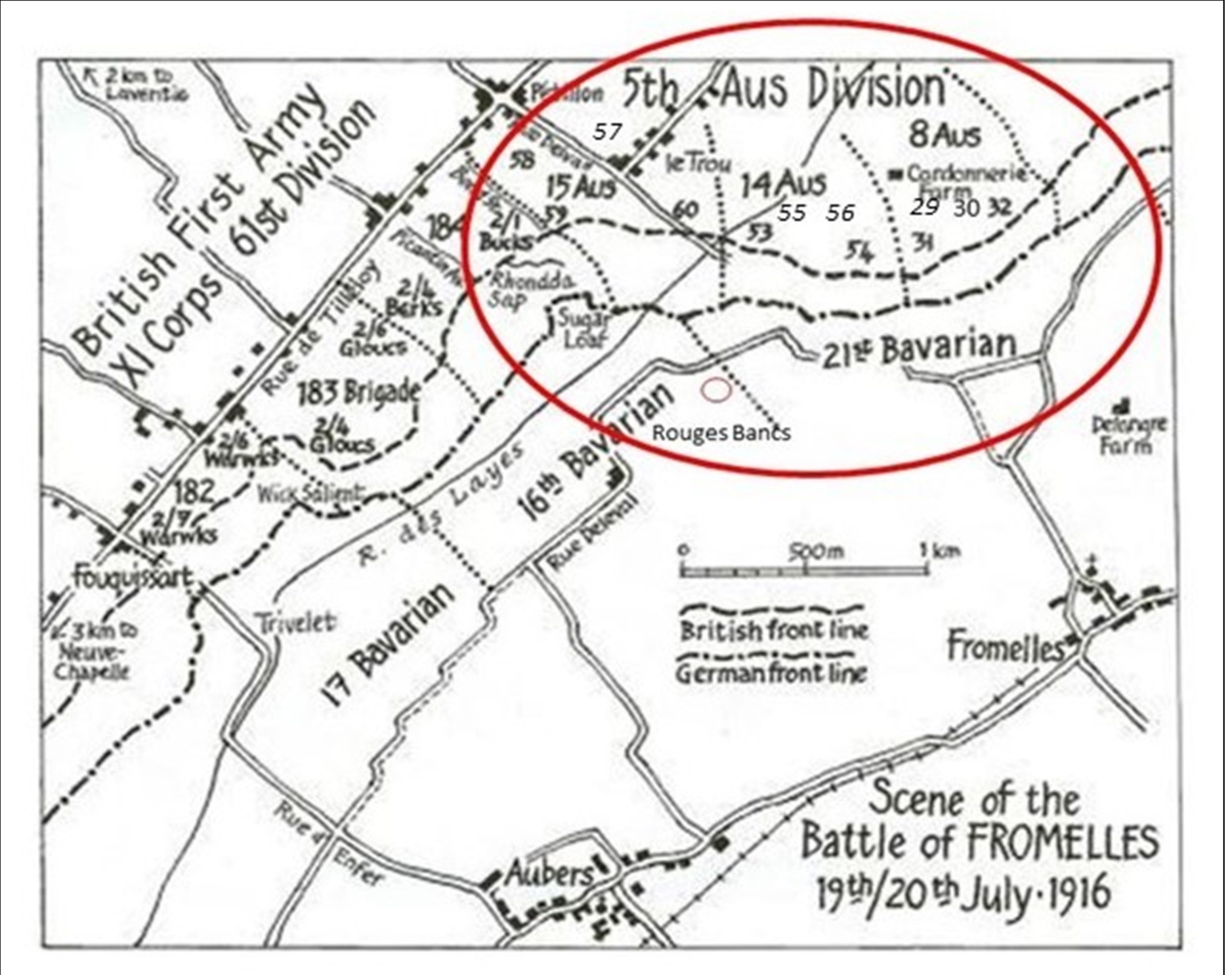
The plan was that the Australian Fifth Division were to be a part of an assault on the German trenches. The 31st and the 32nd battalions were on the extreme left flank of the attack. They had to cross 100 metres of no-man’s-land before reaching the German trenches and were then to link up with the 54th Battalion for further advances. They also had the difficult task of having to protect their left flank.
All were in position by 5.45 PM on the 19th. Percy’s D Company and B Company were to form the third and fourth waves of the attack. The charge over the parapet began at 5.53 PM, but they then laid down until their artillery barrage stopped at 6 PM. The first and second waves attacked then with the third and fourth waves following. They were successful in the initial assaults and by 6.30 PM were in control of the German’s 1st line system (map Trench B), which was described as “practically a ditch with from 1 to 2 feet of mud and slush at the bottom”.
Source AWM4 23/49/12, 32nd Battalion War Diaries, July 1916, page 11
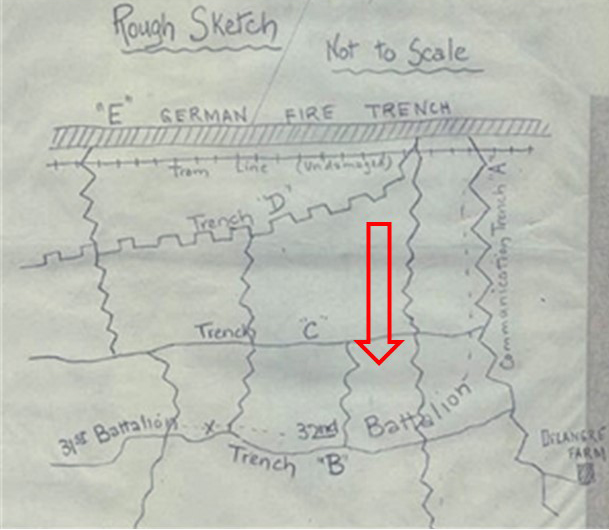
Unfortunately, with the success of their attack, ‘friendly’ artillery fire caused a large number of casualties. They were able to take out a German machine gun in their early advances, but they were being ‘seriously enfiladed’ from their left flank. By 8.25 PM a message was received that their left flank was subject to heavy bombardment with high explosives and shrapnel shells. A request for urgent reinforcements was made, however, the reply that “the trenches were to be held at all costs”.
Source AWM4 23/49/12, 32nd Battalion War Diaries, July 1916, page 12
Fighting continued through the night. The Australians made a further charge at the main German line beyond Trench B, but they were low on grenades, there was machine gun fire from behind and from the emplacement at Delangre Farm and they were so far advanced that they were getting shelled by both sides.
By 4.00 AM on the 20th, the Germans had been reinforced and were attacking the 32nd’s left flank, pushing the Australians out of the communication trench they had captured. Given the Australian advances that had been made earlier, the rear Trench E had been left almost empty, which then enabled the Germans to be in a position to surround the soldiers of the 32nd. At 5.30 AM the Germans attacked from both flanks in force and with bombing parties.
With mounting casualties from the artillery and German machine gun fire, and continued German counter attacks they were forced to withdraw. What was left of the 32nd had finally withdrawn by 7.30 AM on the 20th. The initial head count was devastating – 71 killed, 375 wounded and 219 missing. To get some perspective of the battle, when Charles Bean, Australia’s official war historian, attended the battlefield two and half years later, he observed a large amount of bones, torn uniforms and Australian kit still on the battlefield.
The final impact was that 226 soldiers of the 32nd Battalion were killed or died from wounds sustained at the battle and of this 167 were unidentified. As of 2024, 41 of these soldiers from the 32nd have been identified from the German mass grave at Pheasant Wood found in 2008.
D Company’s Lieutenant Sam Mills survived the battle. In his letters home, he recalls the bravery of the men:
“They came over the parapet like racehorses……… However, a man could ask nothing better, if he had to go, than to go in a charge like that, and they certainly did their job like heroes."
Percy’s Fate
Not unexpectedly, exactly what happened to Percy is unknown. Sophia was sent a telex on 13 August advising Percy was wounded. By mid-September she was advised there was no further information, but by 4 October he was now ‘missing, not wounded’. Not a good sign this late after the battle.
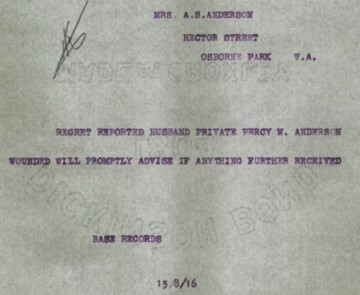
Red Cross witness statements began to come in in December, but they had conflicting information. Adding to the potential reporting confusion from battle witness reports, there was a Private A.B. Anderson (1206) from D Company who was wounded in the battle (but survived).
On 9 December 1916 Private Archibald William Cameron (1251) from Percy’s D Company reported:
“I knew a Pte. P.M. Anderson.” “He had been wounded.”
On 18 February 1917 Private S.M. Redmond (1351), also of D Company, reported:
“Informant states that on 19th July 1916 at 8.30 p.m. at Fleurbaix he saw Anderson last in No Man's Land during an attack. At the beginning he was hit by shrapnel and killed.”
Major R.A. Geddes, 32nd Bn, stated on 26 May 1917:
“I saw Anderson badly hit by a shell in the German trenches at Fromelles on the 20th July. We had to retire later and he was left in the German Trenches. I think he was fatally wounded.”
The Red Cross Enquiry file also contains a heart wrenching letter from Percy’s father, written in March 1917 whilst he was stationed at Harefield Park. He pleads for information in relation to Percy noting “I have 2 other sons in France and they are also anxious to hear about their brother.”
Source: Australian Red Cross Wounded and Missing Files – Percy Michael Anderson, p 7
With no further meaningful input and no reports of Percy being captured or found by the Germans, a Court of Inquiry in the Field on 25th August 1917 pronounced Percy as having been Killed in Action on the 20th.
Remembering Percy
Sophia remained a widow until she married William Glass on the 16th July 1927. He was awarded the 1914/15 Star, British War and Victory Medals, as well as a Memorial Plaque and a Memorial Scroll.
He is commemorated at VC Corner Australian Military Cemetery, Fromelles France and Kings Park Memorial Drive.
In 2011 his family dedicated a memorial plaque to Percy in the Avenue of Honour on May Drive in Kings Park, Perth.
Could Percy Still Be Found?
Percy has no known grave. He was 25 years old. After the battle, German soldiers removed 250 Australian casualties from the battlefield, burying them in large pits near Pheasant Wood. This mass grave was not discovered until 2008. As of 2024, 180 of the 250 soldiers in the grave have been able to be identified by DNA matching from family members. 41 of the 167 unidentified soldiers from the 32nd have been found to be in the grave. Percy may be one of the 70 remaining soldiers in the grave who are not yet identified. Family members have assisted to provide DNA for Percy.
Seeking DNA Donors

Contacts
(Contact: royce@fromelles.info or geoffrey@fromelles.info).
(Contact: army.uwc@defence.gov.au or phone 1800 019 090).
Donations
If you are able, please contribute to the upkeep of this resource.
(Contact: bill@fromelles.info ).
